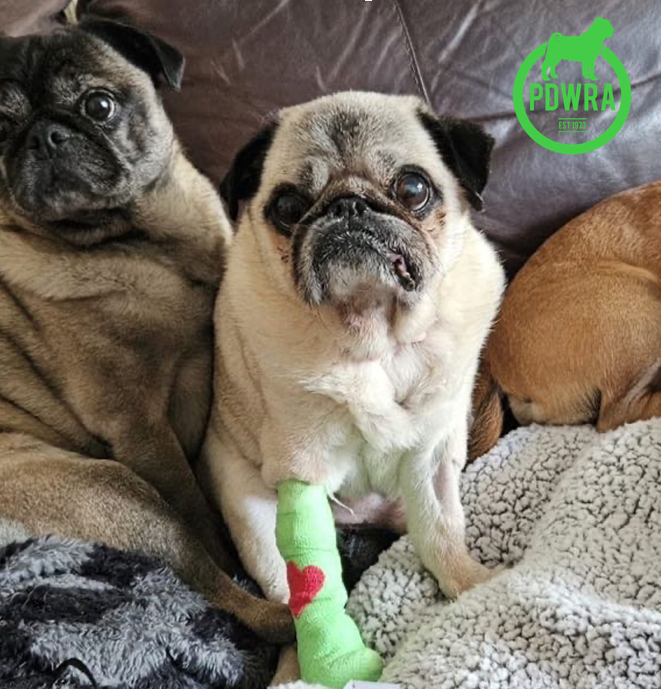Article by Helen McKee (MRCVS)
PDWRA Vet Advisor.
This month I have decided to write about the condition of Protein Losing Enteropathy (PLE), as there have been a number of PDWRA pugs with the condition that has not been diagnosed by their veterinary surgeon.

Unfortunately, like so many other diseases, PLE is over-represented in pugs; I have seen more cases in the last 5 years working (voluntarily) for the Charity, than I ever saw when in practice.
PLE is an umbrella term for a group of diseases that damage the gut to such an extent that it not only has difficulty absorbing nutrients but also leaks protein out of the body.
It is caused by a number of conditions, including Inflammatory Bowel Disease (IBD), which is similar to Crohn’s Disease in people, Lymphoma, a tumour that infiltrates the gut, and Lyphangectasia, a swelling of the lymph vessels, which is often secondary to the first two diseases.
The disease I’ve most commonly seen in pugs that causes PLE is IBD, but I have also seen cases of lymphoma. However, both are treated the same way, so a definitive diagnosis is not necessarily needed. More on this later.
There are a few reasons a dog may develop IBD/PLE, including a food sensitivity and most commonly, overactive immune response (‘immune-mediated’).
The most common clinical signs associated with protein-losing enteropathy are primary gastrointestinal signs, like vomiting and diarrhoea. Chronic cases often result in excessive weight loss, dehydration and generalised weakness.
A chronic inflammatory response of the mucosal lining of the intestines leads to progressive damage, severe protein leakage, and improper nutrient absorption in dogs.
If your pug has had chronic (over 4 weeks) diarrhoea, that has not responded to normal protocols, your vet may culture the faeces and look for bugs such as Giardia and Salmonella. Giardia and overgrowth of gut bacteria are treated with a drug called Metronidazole (Metrobactin). Your vet may also prescribe a pro-biotic such as Pro-Kolin.
A bland highly digestible diet is also often prescribed.
If the symptoms continue, your vet might advise X-rays/ultrasound of the abdomen.
However, the most important test is a complete haematology and biochemistry blood profile. I like to request that the bloods go to an external lab to ensure accuracy.
If, along with the clinical signs, the blood albumin is low, it is highly likely to be PLE. There may also be signs of anaemia, low folate/B12 and inflammation.
If the disease has been left untreated for a while, the albumin levels can drop so low that it is life threatening. A critical level to sustain life ifs 15g/L.
To make a definitive diagnosis, gut biopsies may be suggested, however, since the main causes of PLE in a pug are treated the same way, then this may not be necessarily needed especially if finances, or the welfare of the dog doesn’t allow it.
We treated our 11 year old pug Hugo without carrying out a biopsy and after 9 months of treatment he is now in remission.
PLE caused by IBD or lymphoma are treated with immune suppressive drugs. Ideally catch the disease early and hit hard with the medication, which can then gradually be reduced.
The most common drug is prednisolone, at initial doses of 10mg (even 15mg) once daily. Sometimes another drug is added if there’s an initial poor response, such as 2-4 weeks of Clorambucil.
Medication should be gradually reduced to minimum dose that is beneficial.
Cobaplex should also be given, which is a vitamin B supplement, as the condition causes a loss of this very important vitamin.
Finally, diet is very important. Hypoallergenic diets are often prescribed, made by companies like Royal Canin and Purina. Other diets that can work well with the condition are highly digestible low fat diets; I like Hill’s tinned low fat ID or Hill’s turkey ID, small amounts fed frequently to allow absorption by the damaged gut.
There are different levels of severity of IBD/PLE, so unfortunately some dogs deteriorate despite treatment, however others can go on to live for some time with the condition.
Wayne, who was surrendered into our care because of his condition (which was diagnosed by gut biopsy) and adopted by Barrie and Chris Jasper, survived 3 years, though I have seen other pugs die within a few months of diagnosis.
It is a condition that is managed and not cured, and dogs can have flare-ups.
My take home message from this is, if you have a pug that has had diarrhoea for more than 4 weeks that has not responded well to diet change and metronidazole, request a full blood profile (haematology and biochemistry) from an external lab. If the blood albumin is low, discuss with your vet the option of treating for PLE/IBD. The earlier it is treated, the more likely it will respond.
This article is dedicated to Fudge Wilkinson, pictured above, a PDWRA pug owned by Kerry and Pete, who sadly recently died of PLE.
Helen McKee (MRCVS)
PDWRA Vet Advisor.
Pug Health & Wellbeing | The Pug Dog Welfare & Rescue Association (pugwelfare-rescue.org.uk)

